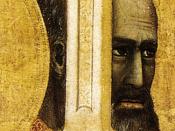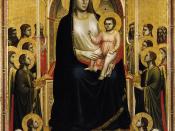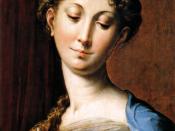Giotto and Parmigianino
The artist Giotto di Bondone was born about 1266 in the village of Vespignano, near Florence. Outstanding as a painter, sculptor, and architect, Giotto was recognized as the first genius of art in the Italian Renaissance. He lived and worked at a time when people's minds and talents were first being freed from the shackles of medieval restraint, dealing largely with the traditional religious subjects.
Giotto is regarded as the founder of the central tradition of Western painting because his work broke free from the stylizations of Byzantine art, introducing new ideals of naturalism and creating a convincing sense of pictorial space. In the generation after his death he had an overwhelming influence on Florentine painting, and his work was later an inspiration to Masaccio, and even to Michelangelo.
He had a grasp of human emotion and of what was significant in human life. In concentrating on these essentials he created compelling pictures of people under stress, of people caught up in crises and soul-searching decisions.
His figures have a completely new sense of three-dimensionality and physical presence, and in portraying the sacred events he creates a feeling of moral weight rather than divine splendor. He seems to base the representations upon personal experience, and go straight to the heart of a story and express its essence with gestures and expressions of unerring conviction.
The earliest of Giotto's known works is a series of frescoes on the life of St. Francis in the church at Assisi. In about 1305 and 1306 Giotto painted a notable series of 38 frescoes in the Arena Chapel in Padua. The frescoes illustrate the lives of Jesus Christ and of the Virgin Mary.
The greatest of Giotto's panel paintings is that of the Ognissanti Madonna, or Madonna in Maestà . The enthroned Virgin...



NICE
WAY TO KEEP THE AUDIENCE INTERESTED!!!!
0 out of 0 people found this comment useful.